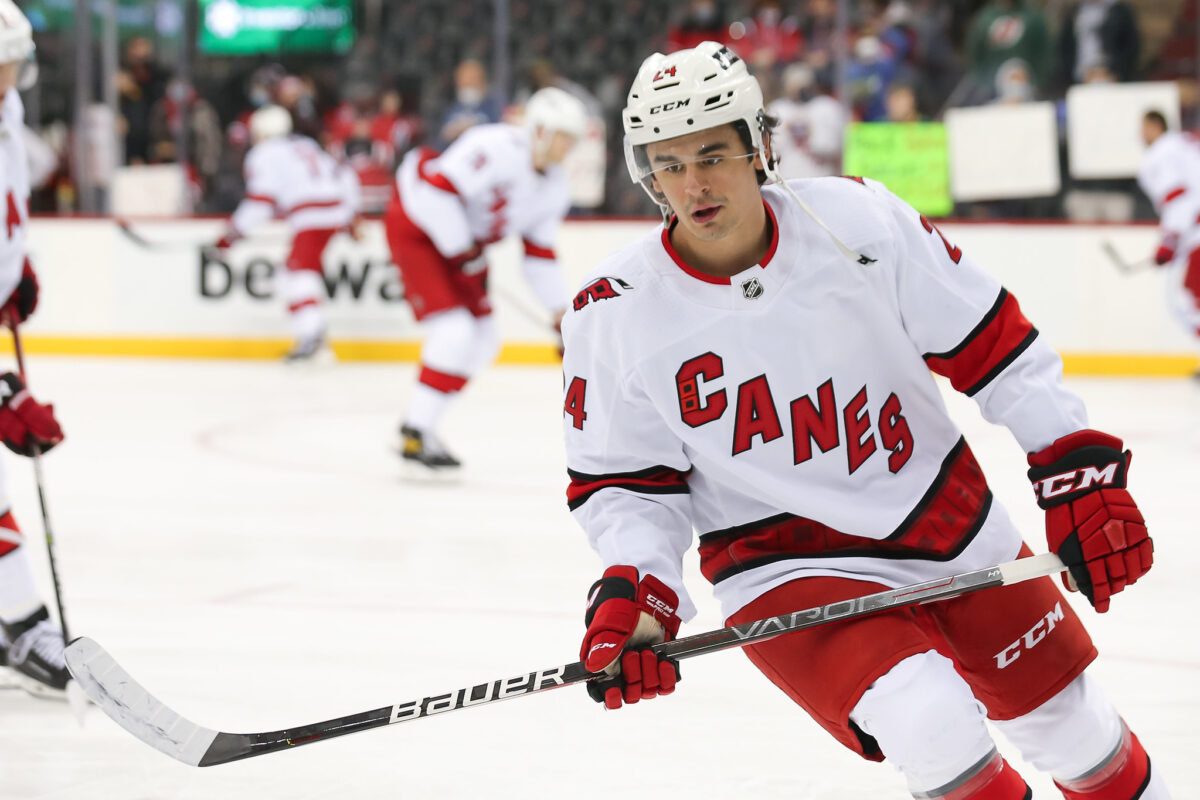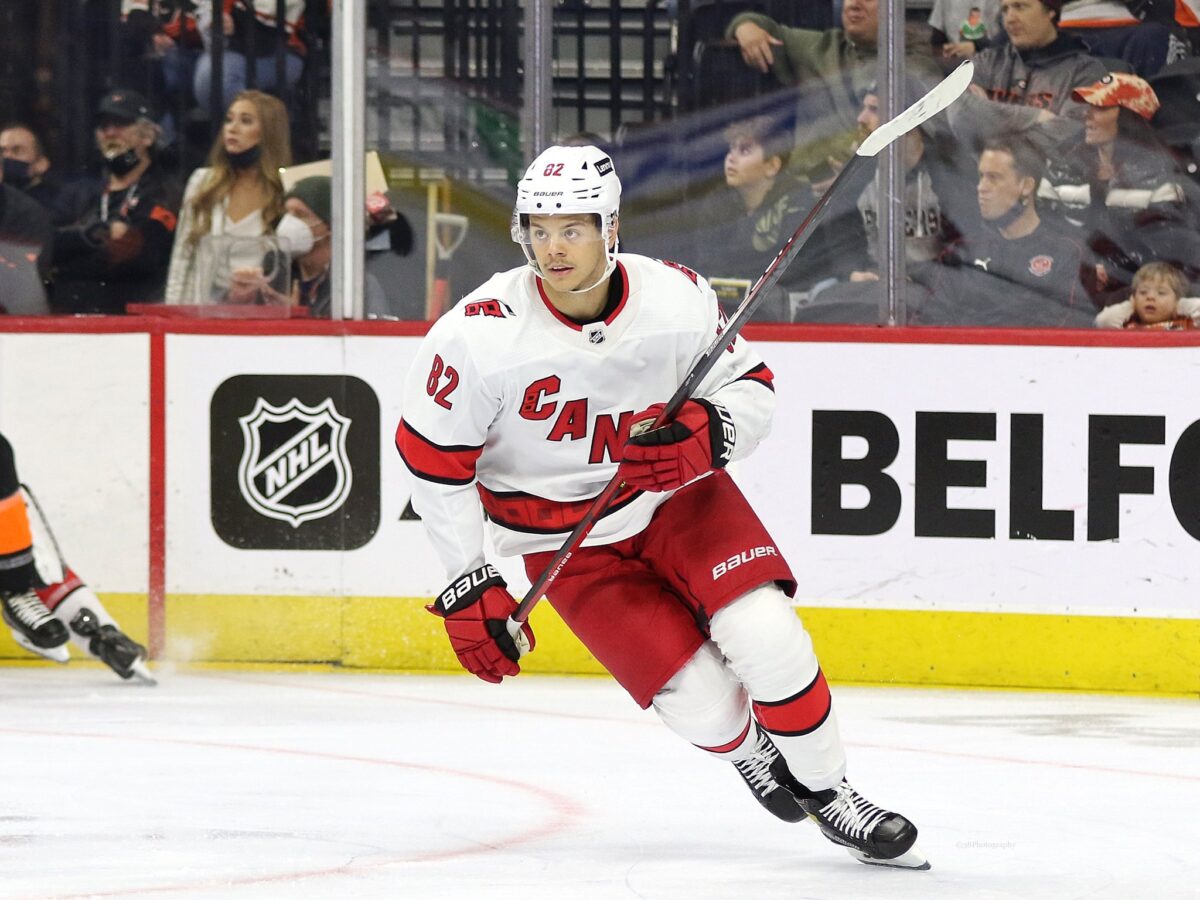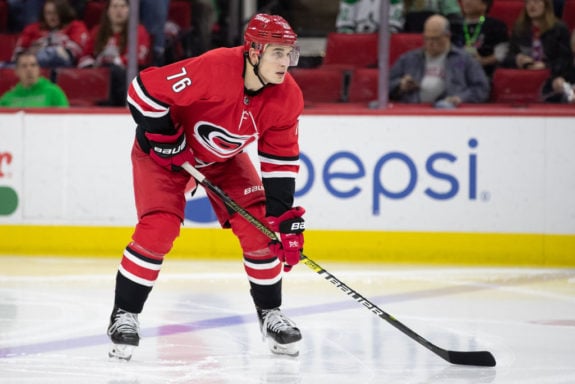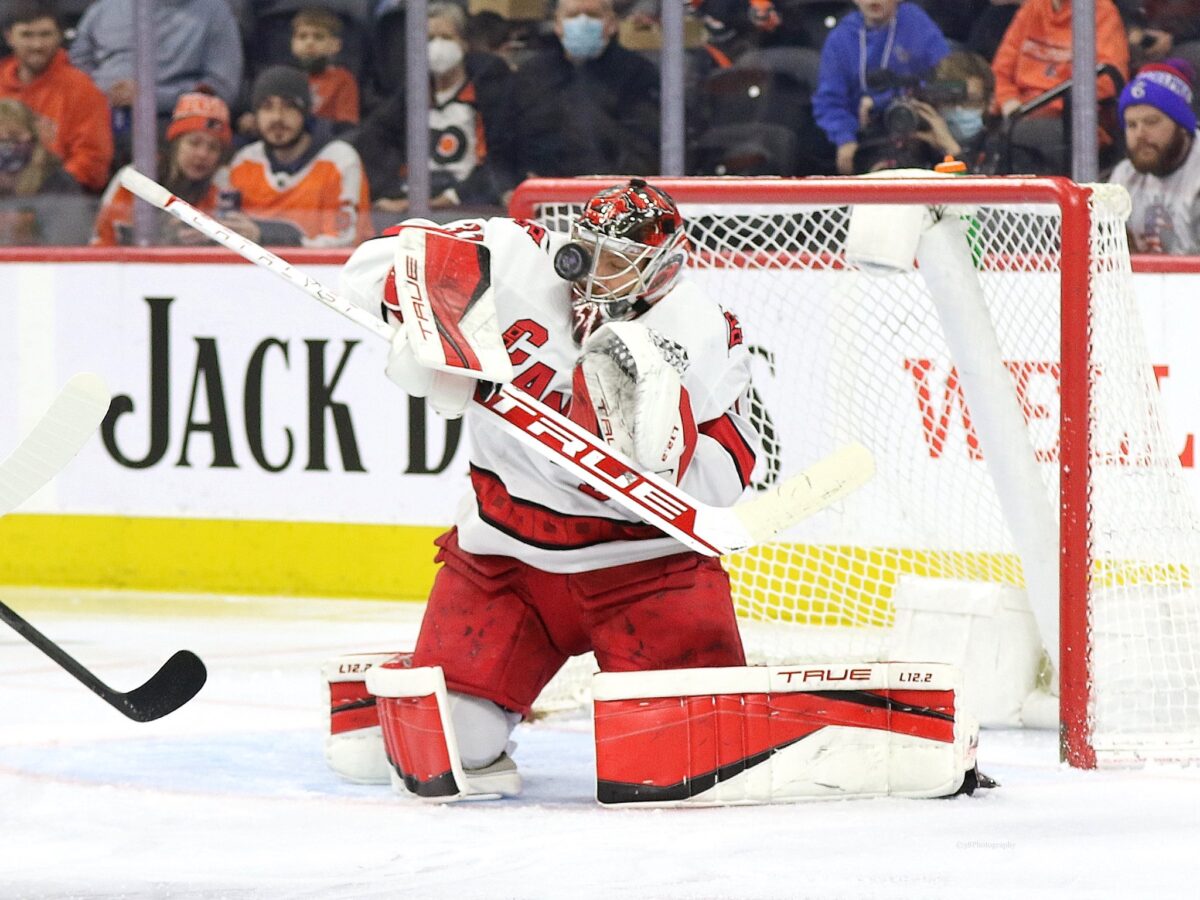I’m sure there have been some, but off the top of my head, I can think of very few tougher 72-hour stretches than the one the Carolina Hurricanes just completed. Having to play at the St. Louis Blues, having one day off, then visiting the Washington Capitals and Tampa Bay Lightning on a back-to-back is not a simple task. In fairness, the final leg of that clearly came back to bite the team a bit – they certainly weren’t at their best, getting out-shot 32-19 and falling short of extending their four-game win streak. But altogether, the Hurricanes took five of a possible six points in that trio of games. If you’re a fan of the team and wouldn’t have accepted that outcome if offered beforehand, either you’re a liar or your expectations are highly unrealistic.
The biggest culprit for the team’s recent success has been the offensive explosion, scoring a whopping 16 goals in the last three games. 13 of those came in the first two games, which were downright dismantlings of two high-end teams that perhaps are not top-tier Stanley Cup contenders, but still have the talent throughout their rosters to be factors deep into the postseason. Even during the game against the Lightning, the team rarely had consistent pressure, but they seemed to capitalize on every grade-A opportunity they got on one of the best goaltenders on the planet.
Some of this is simply positive regression. The team recently went through a rough stretch of heavily out-playing teams, more than doubling them up in shots, and simply getting “goalied.” Look no further than Alexandar Georgiev and the New York Rangers, or Scott Wedgewood’s debut with the Dallas Stars. There was too much talent on this team for losses in games like that to continue, and we’re seeing that balance out a bit.
However, there is far more to the story than that, too, so we’re going to jump into three of the biggest reasons the Hurricanes are making a loud statement of their Stanley Cup candidacy for the 2021-22 season. Ups and downs happen over the course of the season, and with 15 games remaining, it’s entirely plausible that the goals dry up again at some point. The playoffs are often about who gets hot at the right time, though, and the Hurricanes are showing that when that happens, if it happens during the postseason, there may not be much any opponent will be able to do about it.
Two Youngsters Stepping Up in a Big Way
Back to the “ups and downs” thing, it’s especially pronounced for young players. Just look at the team’s two franchise players; we saw Sebastian Aho fight through his share of struggles early in his career, and Andrei Svechnikov was snakebitten for basically his entire third season in the league. For 23-year-old Martin Necas (incidentally, in his own third season) and Seth Jarvis, a teenager a majority of the season before turning 20 on Feb. 1, we’ve definitely seen big ebbs – and perhaps even bigger flows. However, both of them have played key roles in the offensive turnaround, and that could be a huge, huge sign for the Hurricanes down the stretch.

I’ll admit I was unsure about Jarvis’ move to the top line, as the rookie has been physically overmatched at times, and after a hot start, really hit a wall about midway through the season. However, the move has paid off handsomely, and he may stick alongside Aho and Teuvo Teravainen moving forward. He’s had noticeable jump, and on many occasions has been the Hurricanes’ most active forward on the forecheck and in the dirty areas. This is especially key for a skilled player with questions about how he would hold up at his size (5-foot-10, 175 pounds); he’s shown a willingness to take a hit to make a play, and protects himself relatively well. The production is back, as after finishing a beautiful deflection goal and adding a helper against Tampa Bay, he’s got multi-point efforts in four of the last seven games (five goals).
Necas has had one of the more frustrating seasons amongst all Carolina players, as he still routinely flashes the speed, hands, and vision that made him worthy of his first-round selection in 2017. Yet, he’s ended up in head coach Rod Brind’Amour’s doghouse on multiple occasions, with rough turnovers borne out of trying to do too much and lackadaisical play off the puck usually the main culprits. However, a bit of a lucky bounce on a long, seemingly harmless shot on the power play against Tampa Bay last week has seemed to get him going a bit. He then played a huge role in the two wins over the weekend, putting up five points (three goals) in the two games. Sometimes all it takes is a little puck luck, right?
Needless to say, keeping these two highly-talented players hot will do wonders for this lineup. Aho’s line can’t be relied upon to put up all the scoring, and as good as Jordan Staal‘s line has been for months now, they make their money shutting down opposing top lines and simply chipping in offensively on occasion, not consistently (although Nino Niederreiter deserves his own mention, as his hot streak just about deserves its own section in this writeup; he’s now up to 21 goals on the year). If Carolina continues to get this kind of production from their secondary pieces, it’s going to be extremely difficult to consistently slow down their offensive attack.
A New-Look, Four-Lines-Deep Forward Lineup
We’ve already touched on the top three lines, but it can’t be understated how important the fourth line has been, too. The Jesperi Kotkaniemi injury is obviously a tough blow here, and with the severity still unknown it certainly casts a cloud over the team at the moment. But when he was pairing up with Derek Stepan and trade deadline acquisition Max Domi over the last few games, it gave the Hurricanes the ability to roll four lines and threaten to score no matter who was on the ice.

After taking a game or two to settle in, we’re starting to see why the Hurricanes traded for Domi over the last few games. It was assumed his high-compete style would fit in well with a relentless forechecking team, and the skill has started to pop more frequently now that he’s getting more and more comfortable in the system. He always seems to be around the puck, and the vision that allowed him to post 72 points in 2018-19 has been a boon to a fourth line that overmatches most other bottom six units throughout the league. He had two beautiful assists against Washington, and should have had another against St. Louis that was mysteriously taken away after initially being accredited.
Related: Hurricanes Shore Up Forward Depth With Domi & Kotkaniemi Deals
Even without Kotkaniemi, the Hurricanes have an excellent bottom-line trio with Domi, Stepan, and Steven Lorentz, that can effectively eat minutes, wear down opponents on the forecheck, and responsibly play in their own end. All three of these players (four, if you include Kotkaniemi) could, and likely would, be playing higher up the lineup for other teams in the league. That skill, and versatility, with the ability to move guys around when injuries strike or ineffectiveness suggests a change is needed is a luxury not afforded to many teams.
Credit to general manager Don Waddell; many fans were hoping for a “big fish” addition that truly signaled the team’s “all-in” mentality in this season – even if it would have taken a ton of cap gymnastics to pull off. Early on, though, Domi is proving his addition could be the missing piece that rounds out one of the deadliest forward groups in the NHL. Adding that kind of talent, even if only a rental, and only giving up a player unlikely to come back over from Russia and a raw defender likely at least four or five years out from contributing at the NHL level, is extremely impressive work.
Defensemen Pitching in, Too
Finally, it’s not just the forward group that has stepped up to create offense over this stretch. While, yes, some of the defensemen on this team are expected to, or even counted on, to contribute, some of the less-usual suspects have been notably efficient in that end of the ice lately, too. Tony DeAngelo is obviously on this team to create offense from the back end, and he’s done so all year, but the other blueliners helping put the puck in the net takes this squad to another level.

We’ll start with the perpetually-under-appreciated Jaccob Slavin. He’s played in an additional 13 games than last season (65 vs. 52), but he’s more than doubled his point production to 34 from 15. Now, last season was actually a bit of an offensive slide from where we’ve become accustomed to seeing the alternate captain, but it is good nonetheless to see him jumping into the play a bit more liberally this season. Brind’Amour has said on many occasions how important that element is for this system. While he has just three goals, Slavin has chipped in 31 assists on the year. Incidentally, along with DeAngelo’s 33, two Hurricanes defensemen have eclipsed the 30 assist mark in the same season for the first time since 1989-90, when the team was still in Hartford.
The even bigger story has been the second pairing becoming reliable offensive contributors, with both Brett Pesce and Brady Skjei not only scoring, but seeming to step up with timely goals pretty regularly. Pesce’s overtime winner in Philadelphia was obviously clutch, but also displayed a heck of a lot of skill that we don’t always see from primarily shutdown defenders. The way he knocked the puck out of midair then finished high to the glove side looked like a high-end sniper, not a shutdown defender. His value shouldn’t be understated as a guy who can do both. He has two goals and three points in the last three games, and has tied his career-high in goals with seven – meaning setting high marks in both goals and points (high is 29, currently at 22 in 2021-22) is within reach.
Perhaps an even bigger surprise, though, is Pesce’s partner, Skjei. At times a whipping boy for the Carolina fanbase over the last couple years, his first full, semi-normal season in Carolina has seen him step up offensively, too. He’s had a pretty weird career from an offensive standpoint; he’s not the most skilled guy in the world, but he has a decent shot and is a great skater, so he’s had stretches, although somewhat infrequent, where the points rolled in. Hell, he nearly scored 40 points as a rookie in 2016-17. In the four seasons after, though, he never even broke 25.
Until this year, that is, as Skjei has really settled in with his new team, and like Pesce, become a reliable two-way force. Still eating huge minutes at over 21 minutes per game, since Jan. 1, only Victor Hedman, Roman Josi, Devon Toews, and Cale Makar have scored more goals than Skjei’s seven. He’s played a key part in this recent surge too, with four points over the last four games. If these back-end players continue to aggressively pinch in the play – along with Ethan Bear once he returns, who looked great on the second power-play unit with his wicked shot and underrated poise and vision – the Hurricanes should be able to continue keeping pace offensively with any team in the league.
Hurricanes Ready for Postseason Play, Hope for Health
The 6-1 win over Washington felt like a statement. The Hurricanes hadn’t won a game against their former Southeast Division rival this season, but proved to themselves they could. The overtime loss to Tampa Bay gave them points in every game against the two-time defending Stanley Cup champions, after they won the first two matchups. While you’d like to have gotten a win over Florida, the other obvious Eastern Conference contender who swept Carolina in the season series, this team still looks primed to take on any comers in the postseason.
Now, it’s all about health. We await updates on Kotkaniemi’s status, but with a five-point lead in the Metropolitan Division with 15 games remaining, the Hurricanes just hope to lock down the one seed without suffering any more injuries. While they remain well-equipped to handle any losses thanks to their depth at both forward and defense, the unfortunate aspect is that their ideal lineup was really starting to look like they were firing on all cylinders. Kotkaniemi himself was playing great hockey leading up to the injury, reunited with Domi, his former Montreal teammate.
The Hurricanes will now get something of a reprieve as far as the schedule goes, returning to the friendly confines of PNC Arena the final day of March to face the Montreal Canadiens. They’ll start April off with the Minnesota Wild and newly acquired goaltender Marc-Andre Fleury, then have a home-and-home with Buffalo in that first week, before facing two more struggling teams in the New York Islanders and Anaheim Ducks. This will be a great opportunity to keep banking points, and this recent 2-0-1 road stretch against three excellent teams ought to have them brimming with confidence. Eight of their last 15 games are on home ice.

This team was built on defense, and they have a Vezina candidate between the pipes in Frederik Andersen. Antti Raanta has matched the starter’s play of late too, giving the Hurricanes perhaps one of the best tandems in net they’ve ever had. If they had enough offensive firepower to match the likes of Florida, Tampa Bay, and if they can reach the Final, Colorado, was always the biggest question for me. We won’t know if they truly do until they get into the playoffs, but the upside they are currently showcasing is putting teams on notice. This is going to be a scary team to match up with in a seven-game series, and I can’t wait to watch the battles begin. We’re almost to the best time of the year, folks – NHL playoff time is right around the corner.